Fitness
Yes, you can find a good quality exercise bike under $500 — these are the best
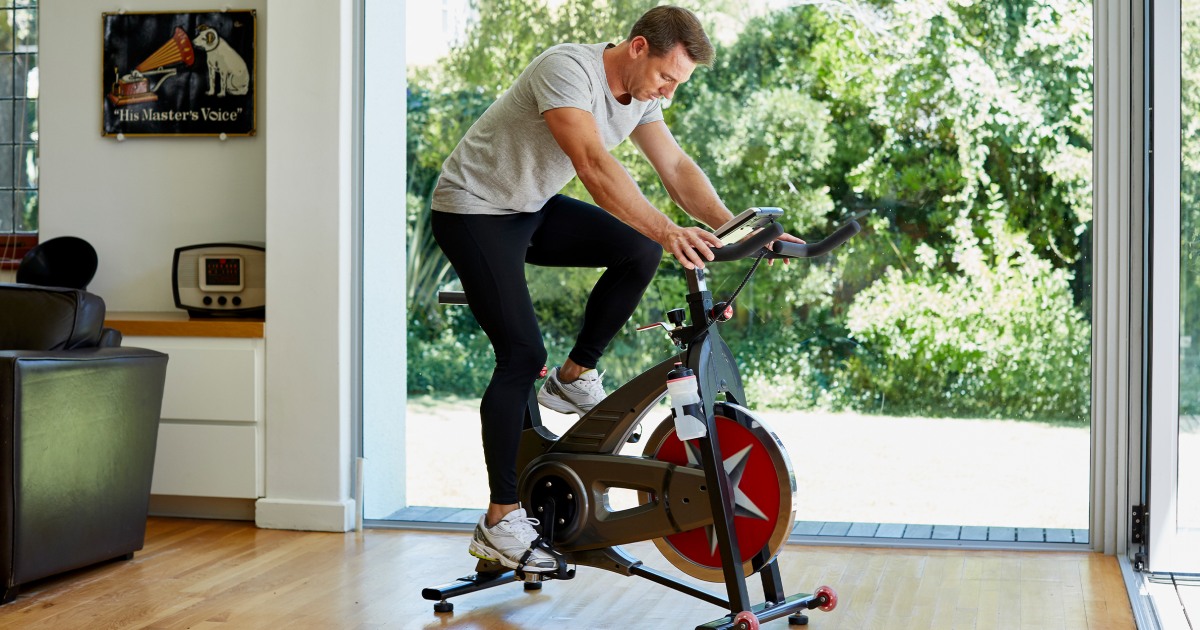
If you want a good cardio session but don’t want to brave the elements — whether heat, cold, rain or snow — an indoor exercise bike is a solid way to burn some calories from the comfort of your own home. To help you navigate which ones offer the best ride, we’ve rounded up a list of several highly rated stationary bikes under $500 that align with expert guidance.
Today’s home bikes span a range of styles and price points. While the pros we spoke to recommend a more expensive bike for serious tracking and online connectivity, they were quick to point out that there are plenty of more affordable exercise bikes that provide everything you need.
“As with any piece of exercise equipment, the best one is the one you are going to use consistently,” says Chicago-based certified personal trainer Eric Ridings.
SKIP AHEAD How we picked the best budget exercise bikes | The best budget exercise bikes to consider in 2024 | How to shop for budget exercise bikes | What kinds of accessories can I buy for my exercise bike? | Why trust NBC Select?
How we picked the best budget exercise bikes
To compile this list, we spoke to personal trainers about what features you should look for in an affordable exercise bike that will give you a great cardio workout. Based on their expert advice, we picked 13 highly rated bikes, paying special attention to the following criteria:
- Maximum weight capacity: We looked for stationary bikes that can hold at least 265 pounds.
- Adjustability: All of the bikes we recommend have either adjustable handlebars and seats (or a combination of the two).
- Resistance: All of the bikes considered offer a resistance knob so you can customize your workout routine.
The best budget exercise bikes to consider in 2024
The exercise bikes in this roundup are readily available at NBC Select reader-favorite retailers such as Amazon, Walmart and Target, along with popular brands, including Sunny Health, Nautilus and Echelon. As an added bonus, most of these stationary exercise bikes give you a 30-day return policy if you’re not fully satisfied with your new purchase. All of these bikes have a customer rating of at least 4.3 stars.
Best overall budget exercise bike: Yosuda Pro Magnetic Exercise Bike
What we like
- Quiet handling
- Easy assembly
Something to note
- Dim backlight on LCD screen
This bike from Yosuda has a magnetic drive system, so it’s super quiet, according to the brand. It also has an LCD monitor that tracks calories burned, speed, distance and time spent pedaling, as well as a resistance knob with 100 micro-adjustable levels so you can customize your exercise routine. A dedicated holder allows you to position a tablet so you can ride along to a workout app, and it has a padded seat, toe-caged pedals and non-slip handlebars that can be adjusted four ways to fit your frame and stride.
Maximum weight capacity: 350 pounds | Digital monitor: Yes | Warranty: 30-day full-refund guarantee and 1-year free parts replacement | Rating: 4.3 star-average rating from 1,693 reviews on Amazon
Best budget exercise bike for small spaces:Ativafit Folding Exercise Bike
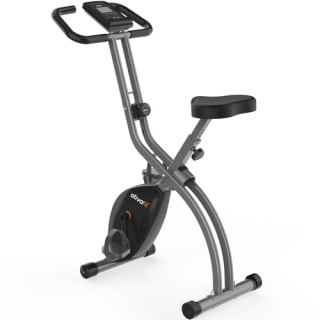
What we like
- Great for small spaces
- Very quiet
Something to note
- Small seat space
- No warranty
This foldable bike is good for smaller spaces. It has an adjustable seat and eight levels of magnetic resistance, as well as a digital monitor to track time, speed and your pulse. It has a magnetic flywheel that is very quiet, allowing you to watch television or listen to music without distraction while riding, according to the brand.
Maximum weight capacity: 265 pounds | Digital monitor: Yes | Warranty: None | Rating: 4.4-star average rating from 16,538 reviews on AmazonBest versatile budget exercise bike: Kalwol
Best warranty on a budget exercise bike:Luminofit Indoor Cycling Bike
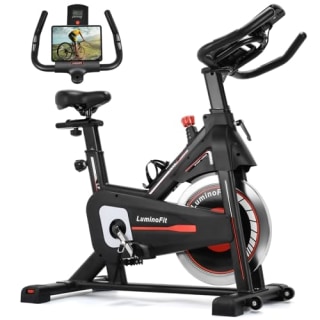
What we like
- Adjustable seat and handlebars
- Covered by warranty for a year
This bike is made from durable stainless steel and has a heavy-duty flywheel for increased stability while riding, according to the brand. It comes with a four-way adjustable seat and two-way adjustable handlebars and also has a safety brake, which brings the bike to an immediate stop when pushed. The LCD monitor also tracks pulse, time, speed, distance, calories and odometer.
Maximum weight capacity: 330 pounds | Digital monitor: Yes | Warranty: One year for both frame and parts | Rating: 4.6 star-average rating from 222 reviews on Amazon
Best portable budget exercise bike:Sunny Health & Fitness SF-B1002 Exercise Cycling Bike
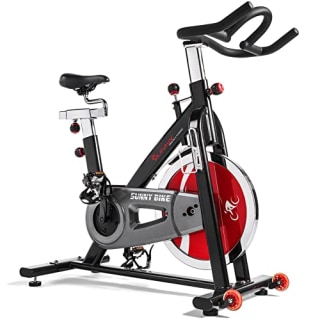
What we like
- Connects to free SunnyFit app
Sunny Health is a favorite among NBC Select readers and fitness pros alike and is a top pick in our various guides to indoor bikes. This durable steel-frame model sports a 49-pound chrome flywheel (a weighted disk that mimics a bicycle wheel) and wheels for easy portability, according to the brand. Users can also buy the Sunny Bike Cadence Sensor and connect to Sunny’s free SunnyFit app to measure and track cycling metrics.
Maximum weight capacity: 275 pounds | Digital monitor: No (Cadence Sensor sold separately can track metrics) | Warranty: Frame one year, parts three months | Rating: 4.6 star-average rating from 246 reviews on Walmart
Best silent budget exercise bike:JOROTO Belt Drive Indoor Cycling Bike
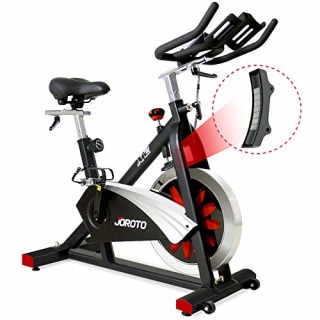
What we like
- Easy assembly
- Quiet pedaling
Something to note
- Only tracks speed and distance
A noisy spin bike can make life miserable for anyone you live with or near (like the neighbors downstairs). The Belt Drive Indoor Cycling Bike uses magnetic resistance — in this case, seven magnets create a magnetic field, which you can adjust for stronger or lighter resistance — which the brand says makes the bike “whisper quiet.” It sports a 35-pound flywheel and four adjustable feet to keep your bike stable on various surfaces. .
Maximum weight capacity: 280 pounds | Digital monitor: Yes | Warranty: 1-year of free replacement parts | Rating: 4.5 star-average rating from 6,930 reviews on Amazon
Best chain-drive budget exercise bike:Sunny Health & Fitness SF-B901 Indoor Cycling Bike
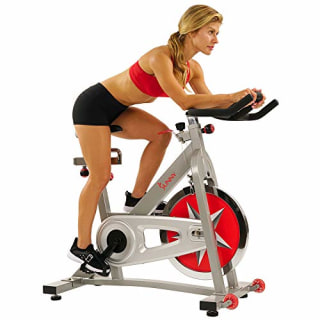
What we like
- Stabilizers prevent wobbling
- Transport wheels for mobility
This chain-drive exercise bike from Sunny Health works similar to an outdoor bike with a chain. It features a 40-pound chrome flywheel, resistance knob, two-way adjustable handlebars and a four-way adjustable seat. Four floor stabilizers at the base of the bike help prevent wobbling on uneven surfaces, according to the brand, and it includes transport wheels to make it easier to move it from room to room.
Maximum weight capacity: 275 pounds | Digital monitor: No | Warranty: 3 months (parts); 1 year (frame) | Rating: 4.4 star-average rating from 7,042 reviews on Amazon
Best digital monitor on a budget exercise bike:Harison Stationary Upright Exercise Bike
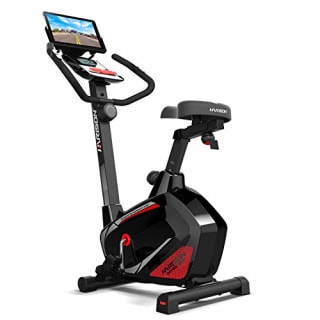
What we like
- Tablet holder
- Adjustable seat and handlebars
The Harison exercise bike features 14 levels of magnetic resistance, a four-way adjustable leather seat with extra padding and adjustable handlebars. There’s an LCD screen that tracks your calories burned, speed, distance, time, as well as a separate tablet holder above the screen and handlebars. It also features nonslip pedals and can safely hold riders up to 350 pounds, according to the brand. .
Maximum weight capacity: 350 pounds | Digital monitor: Yes | Warranty: None | Rating: 4.1 star-average rating from 420 reviews on Amazon
Most versatile budget exercise bike:Echelon Smart Connect Fitness Bike
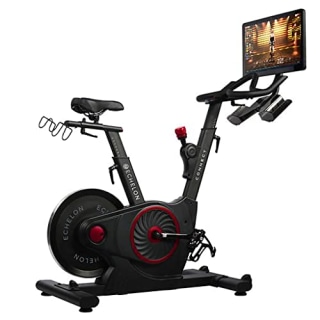
What we like
- Front transport wheels
- Free trial membership
This bike has adjustable toe cage pedals, 32 levels of magnetic resistance and front transport wheels so you can move it around your house. It also has a water bottle holder and a spot for your tablet or phone, so you can follow workouts on the companion app. With the purchase of this bike, you get a free 30-day Echelon Premiere membership through the Echelon Fit app, which gives you access to over 3,000 online spin workouts. Classes range from five to 45 minutes long and are designed for everyone from beginners to pros. After the 30-day trial, the app membership is $40 a month.
Maximum weight capacity: 300 pounds | Digital monitor: No | Warranty: 1 year (limited parts and labor) | Rating: 4.3-star average rating from 2,862 reviews on Amazon
Best adjustable budget exercise bike: Pooboo Adjustable Exercise Bike
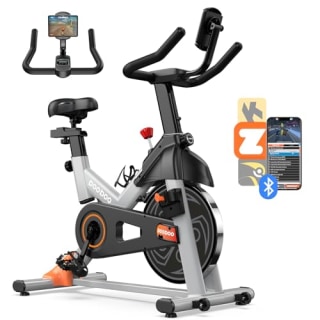
What we like
- Fully adjustable
- Silent wheel
Something to note
- Monitor batteries not included
Pooboo’s adjustable bike runs on a magnetic resistance system that’s almost completely silent, according to the brand. It has an adjustable padded seat, handlebar and pedals that fit a range of heights from 4’9’ to 6’3”, according to Pooboo. It also comes with Bluetooth compatibility and a monitor to help you track your time while riding. However, the display requires two triple-A batteries that aren’t included with the bike.
Maximum weight capacity: 350 pounds | Digital monitor: Yes | Warranty: None | Rating: 4.5 star-average rating from 9,202 reviews on Amazon
Best Bluetooth connectivity: Schwinn Fitness Upright Bike

What we like
- Bluetooth compatibility
- Lots of workout programs
This option from Schwinn offers 14 workout programs via an LCD monitor that tracks your speed, distance, heart rate, calories and more, according to the brand. It has adjustable handlebars and a foam seat for added comfort, along with a weighted flywheel, which gives a smooth and quiet workout, according to the brand. The bike also comes with Bluetooth connectivity features that allow you to sync your workouts, progress and goals with the workout tracking app of your choice. You can also gain access to structured workouts and virtual biking routes with a paid subscription to the Zwift app, which is an app for indoor cycling.
Maximum weight capacity: 300 pounds | Digital monitor: Yes | Warranty: 2 years for parts, 1 year for electronics, 10 years for frame | Rating: 4.3 star-average rating from 5,190 reviews on Amazon
How to shop for budget exercise bikes
Here are the most important things Christopher LaMarco, owner of CrossFit Nauset in Orleans, Massachusetts says shoppers should consider when buying an exercise bike on a budget:
- Weight capacity. Most models can accommodate up to 270 pounds, but some can even go as high as 400. Always check the weight capacity, especially if you have different riders who will be using the bike.
- Adjustability. Having the ability to raise and lower the seat and handlebars to fit your frame and stride is important to ensure a correct posture while riding, says LaMarco.
- Display. Without a display, it’s nearly impossible to track your progress and replicate workouts, says LaMarco. You want to track calories burned, distance and heart rate each time you ride, he says.
- Resistance. Having the ability to adjust your resistance allows you to increase your workout level so you can improve speed, power and strength. An exercise bike should offer at least 10 levels of resistance so you can individualize your workout. Having no resistance could increase your risk of injury, says LaMarco.
- Noise level. Exercise bikes are one of the quieter pieces of gym equipment. Still, there are different noise levels depending on the type of resistance or drive mechanism. Magnetic resistance is generally quieter than friction resistance, and chain and belt drives are even noisier. Ideally, you’ll want to try the bike out to see if the noise bothers you before you buy.
- Safety and stability. The heavier the steel frame and flywheel, the more stable the bike, says LaMarco.
- Portability. A bike that comes with transport wheels allows you to more easily move it from room to room if necessary.
- Warranty. Some bikes under $500 don’t offer a warranty, but many do, either on the frame or parts or both.
- Your space. In general, exercise bikes don’t take too much space. However, some are wider and others need good headroom. Consider your space before shopping to see what type of bike fits best.
What kinds of accessories can I buy for my exercise bike?
There are dozens of spinning accessories on the market today, and many are available right on Amazon. LaMarco says one of the best accessories to consider, if your bike doesn’t already have them, are toe clips for the pedals to lock your feet in place. Other accessories to consider are padded bike seats, an electronic fan, a cup holder, a portable electronic device mount, easy-to-grip support handles or an anti-fatigue floor mat.
Meet our experts
At NBC Select, we work with experts who have specialized knowledge and authority based on relevant training and/or experience. We also take steps to ensure all expert advice and recommendations are made independently and without undisclosed financial conflicts of interest.
- Eric Ridings is a Chicago-based certified personal trainer and the lead coach at Mobility Works, a strength and conditioning center.
- Chris LaMarco is the owner of CrossFit Nauset in Orleans, Massachusetts.
Why trust NBC Select?
Barbara Booth, Ashley Morris and Justin Redman have published several roundups on best exercise equipment for NBC Select, including Best ellipticals and Best women’s walking shoes. For this piece, Barbara interviewed two experts and researched dozens of exercise bikes, choosing the most highly rated options under $500 that aligned with expert guidance.
Catch up on NBC Select’s in-depth coverage of personal finance, tech and tools, wellness and more, and follow us on Facebook, Instagram, Twitter and TikTok to stay up to date.

Fitness
Are embarrassment and intimidation obstacles to getting more exercise? New data

Even the most experienced gym buffs had to start somewhere, and most of them were intimidated and overwhelmed when stepping into the gym at some point in the past. What machine do you start with? What’s that machine for? A barrage of questions flutter through your mind when you embark on your journey to get fit. For many people, working out can seem exhausting before you even start, especially in the modern age of social media, where we often compare ourselves to idealistic snapshots of others. If you feel that way or have ever felt that way, this new data shows you’re definitely not alone. Let’s look at the data.
New data
The new data from Nuffield Health’s Healthier Nation Index is eye-opening and involves a survey of 8,000 people in the United Kingdom. The goal is to help improve people’s health.
Here are the results:
- 40% of people said that gyms are too intimidating.
- 33% of people haven’t dedicated any time to physical activity in the last 12 months.
- Three out of four people weren’t reaching the British National Health Service guidelines of 150 minutes of moderate exercise every week.
- Over half of the people who aren’t moving enough reported low motivation as one of the main reasons behind the lack of exercise.
- 49% of people reported a lack of energy.
Younger people and those with chronic conditions were more likely to face barriers to movement. Lots of younger people said that not knowing how to get started was the main reason for not getting enough exercise.
A decline in mental health

This new data showed that the lack of physical activity correlated with a negative impact on people’s mental health. 28% reported a decline in their mental health in the last year alone. Regular exercise is beneficial for physical and mental health. Physical activity has been shown to improve sleep and a range of psychiatric conditions. Research also highlights that exercise can reduce depression and anxiety and boost your mood. Going out for that run releases feel-good endorphins that can make your day better.
Tips to get started and diminish that intimidation

Regular exercise can reduce your risk of chronic conditions like type 2 diabetes and stroke. Here are some top tips to help you get started with a workout plan and diminish intimidation:
- Consider working with a personal trainer or physical therapist for guidance.
- Consider joining an exercise class.
- Find an accountability partner or a friend who is also starting a workout plan.
- Try to set realistic goals.
- Try to make it fun and stick to the workouts you prefer or enjoy.
- Celebrate small wins.
- Start slowly, and don’t do too much too soon.
- Listen to your body.
- Monitor your progress over time with a fitness tracker to help you stay motivated and see how much you’ve improved.
- Remind yourself of the benefits of exercise and why you’re making this effort to improve your health and fitness.
- See if you can find a time when the gym is less busy so you have more room to familiarize yourself with the equipment and your routine.
- Start at home with remote personal training, an online class, or just a couple of dumbbells and a few exercises until you feel comfortable heading to the local gym.
Fitness
How to make exercise a consistent routine in 2025

By Gwendolyn Bounds
For The Washington Post
Eight years ago this month, like many Americans, I made a resolution to become fit and strong.
About 7 in 10 U.S. adults set goals at the start of a new year, and personal health or fitness goals are the most common, according to Gallup. But by mid-February, 80 percent of the people who set New Year’s resolutions will have abandoned them, Gallup reported.
I, too, had tried before, my pledge generally lasting a few months before old habits (sitting! screens!) returned.
But that year was different. I had a specific goal in mind — to compete in one obstacle course race. Tying my New Year’s resolution to something concrete was a critical first step to exercise being almost a nonnegotiable in my day. Last year, I completed my 56th race.
Once a resolution is made, specific tactics make it more likely to stick. Here is what habit and fitness experts, and my own experience, suggest:
Have a longer-term obtainable goal
Going out too hard is a common misstep, said Peter Duggan, a strength, conditioning and rehabilitation specialist at Fuel Sport & Spine in New York. “People say ‘I’m going to go crazy’ and then come in to see us injured by the middle to end of January,” he said.
Having a longer-term goal and plan is better, suggested Duggan, who works with professional athletes and amateur fitness enthusiasts. That can be as simple as a 5K race in April or a 90-day first-quarter (Q1) challenge where you measure your January progress against your February progress and your March progress against February and January.
This way, you have some form of momentum. But if January blows up because you get sick, then you still have February and March, Duggan advised. Start small if you’re a newcomer: Go from walking or jogging in January a couple of times a week to running 25 minutes two or three times a week in February and longer in March. Then set another goal for the next quarter.
“You can’t just run up Mount Everest,” Duggan said. “You have to start at base camp. Use January or Q1 as base camp.”
Time block and preprogram your workout
Waking up and thinking, “I’m going to exercise at some point today,” is a vulnerable strategy. You must then spend extra time figuring out what you’ll do, when you’ll do it and where — time you probably don’t have in an already full day.

Instead, schedule and block out your exercise moments for the week, in advance, to reduce the likelihood of slipping back into old habits — such as coming home, jumping on the couch and scrolling on the phone.
“Physical activity takes time, and you need to be mindful of your other habits that need to change,” said Chad Stecher, a behavioral health economist and an assistant professor at Arizona State University. “Not only are you building a new habit, but how does that habit fit into the rest of the day?”
My solution: Since I live by my digital calendar for work, each week’s exercise gets scheduled in the same color-coded blocks as my meetings. I don’t skip meetings, so I don’t skip my workout. This removes the barrier of “at some point today.”
Leave yourself visual prompts
Cues, particularly visual ones, are some of the strongest motivators to create a new habit, said Stecher, whose research focuses on habit formation.
For instance, placing your running shoes or workout clothes where they are the first items you see when you wake up reduces the likelihood exercise will slip your mind, Stecher said. It also serves as a commitment reminder that “you intended to do this,” he said.
In my living room, I keep a nice box that holds a yoga mat, balance board and foam roller. Seeing that box each time I walk to the kitchen means I’m more likely to use what’s in it when I have five to 10 minutes to spare.
Accessibility also matters, Duggan said.
“It has to be convenient,” he said. “We all have weeks when we are overwhelmed, but you can still carve out 20 minutes in your living room with some dumbbells or a HIIT [high-intensity interval training] class on an app.”
Build accountability slowly
Recent research suggests the amount of movement we get in a day, as measured by a wrist tracker, is a stronger predictor of mortality than age, smoking or even diabetes.
There is no shortage of apps, fitness trackers and health devices to gather data on our movement. The key is not letting the devices get in the way of actually exercising – especially when we are first building a habit.
“I think if you are new to exercise, you don’t need all the fancy gear,” Duggan said. “Just start. Listen to your breath and feel your heart rate. As you get better, and crave more data, then you can buy more tools like a watch and a heart rate monitor.”
A less complex (and free) tracking tool is what I call “completion signaling” — the act of checking a box and recording your progress when exercise is done. For instance, when doing multiple sets of an exercise at home, I move a pile of machine screws or small rocks from one mug to another. And each time I complete a workout, I mark it as “Done” in my digital calendar.
Each action, however small, is a clear visual for me of forward movement and accountability. Put more simply, the reward of marking a workout as completed feels good; not checking that box feels bad. So, I am more likely to get the workout done.
Make exercise part of your identity
Exercise becomes truly nonnegotiable when it’s part of your core identity, Stecher said, noting a growing body of research linking identity to maintaining behavior change. “Then, when your routine is interrupted, and the normal cues aren’t there, you’ll still go to the gym,” Stecher said.
This rings true. Eight years ago, “fit person” or “athlete” were nowhere among the descriptors my friends and family used for me — nor ones I used for myself. Now, those monikers are as core to my sense of self as “writer,” “spouse” or “daughter.” The tactics above made that possible.
Fitness
How to Get Back in Shape After the Holiday Break
-

 Health1 week ago
Health1 week agoOzempic ‘microdosing’ is the new weight-loss trend: Should you try it?
-
/cdn.vox-cdn.com/uploads/chorus_asset/file/25822586/STK169_ZUCKERBERG_MAGA_STKS491_CVIRGINIA_A.jpg)
/cdn.vox-cdn.com/uploads/chorus_asset/file/25822586/STK169_ZUCKERBERG_MAGA_STKS491_CVIRGINIA_A.jpg) Technology6 days ago
Technology6 days agoMeta is highlighting a splintering global approach to online speech
-

 Science3 days ago
Science3 days agoMetro will offer free rides in L.A. through Sunday due to fires
-
/cdn.vox-cdn.com/uploads/chorus_asset/file/25821992/videoframe_720397.png)
/cdn.vox-cdn.com/uploads/chorus_asset/file/25821992/videoframe_720397.png) Technology7 days ago
Technology7 days agoLas Vegas police release ChatGPT logs from the suspect in the Cybertruck explosion
-

 Movie Reviews1 week ago
Movie Reviews1 week ago‘How to Make Millions Before Grandma Dies’ Review: Thai Oscar Entry Is a Disarmingly Sentimental Tear-Jerker
-

 Health1 week ago
Health1 week agoMichael J. Fox honored with Presidential Medal of Freedom for Parkinson’s research efforts
-

 Movie Reviews1 week ago
Movie Reviews1 week agoMovie Review: Millennials try to buy-in or opt-out of the “American Meltdown”
-

 News7 days ago
News7 days agoPhotos: Pacific Palisades Wildfire Engulfs Homes in an L.A. Neighborhood














